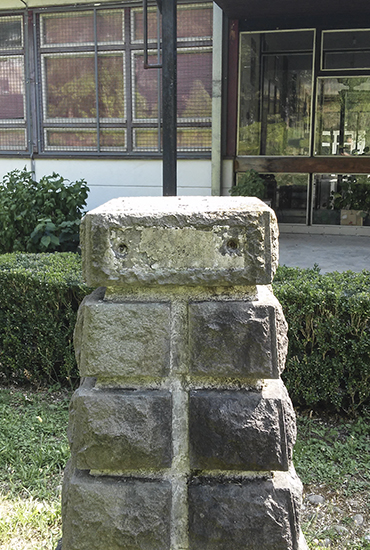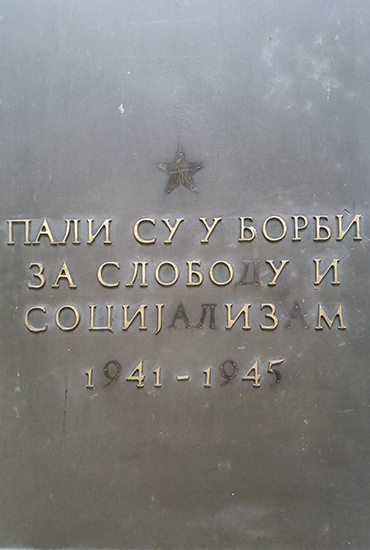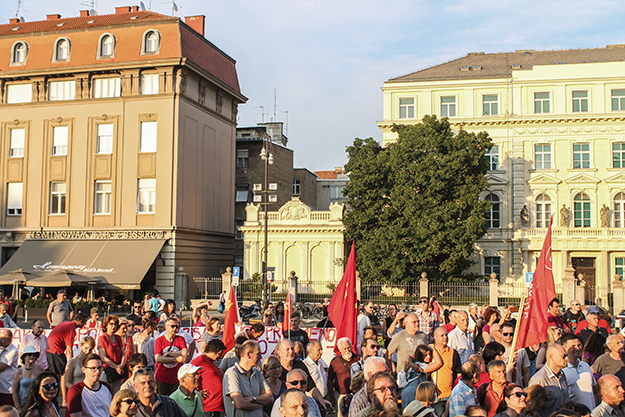One June night in Zagreb, the sign bearing the name ‘Marshal Tito Square’ was removed and unceremoniously thrown into the garbage. The unknown perpetrators didn’t even wait for official confirmation that one of Zagreb’s central squares, that stretches out in front of the National Theater, would be renamed. That confirmation came weeks later on July 21 at a Zagreb City Assembly session, when the Committee for the Naming of Neighborhoods, Streets and Squares accepted the proposal that Marshal Tito Square should become the ‘Square of the Republic of Croatia.’
The “Tito in the trash” picture was shared all over social networks after the name change was announced on June 26 by Milan Bandic, the long-standing, and newly re-elected mayor. “Since I am 61 years old and in my sixth mandate as the head of the city of Zagreb, and I know how to read the signs of the time in this city and beyond, and how to listen to the pulse of the people, I was inclined to … propose something which no normal person in this country should be against,” Bandic proclaimed at a press conference.

Many monuments have disappeared over time and today all over post-Yugoslav countries there are empty spaces where once were heroes. This one is from Rocevici, near Kraljevo, Serbia. Photo: Group of Architects, Serbia.
The decision sparked protests, with accusations of a political trade-off being behind the renaming, and reminders sent to Bandic that he should respect his pre-electoral promise to decide about the square’s name through a referendum.
It is not only Tito’s name which is problematic. Since the ’90s, any connections to people or events linked to the anti-fascist fight, workers’ rights and generally the entire legacy of socialist Yugoslavia have been systematically erased, either by changing the names of streets and squares, or even destroying or neglecting monuments and cultural heritage. This phenomenon is not limited only to Croatia, but takes place in all of the former republics and provinces of Yugoslavia.
Dealing with the past or calculating the future?
By destroying or neglecting reminders of the socialist Yugoslav past, history has been revised, and a new one is being written. Sanja Horvatincic from the Institute of Art History in Zagreb wrote her PhD thesis on the legacy of monuments from the socialist period, and believes that the attitude towards monuments in post Yugoslav states varies considerably from country to country.
“There was almost no destruction in Slovenia,” Horvatincic says. “Monuments are duly recorded, taken care of, and many of them are under protection. Monuments in some parts of Bosnia and Herzegovina and Kosovo have been heavily damaged. It largely depends on the political and wartime environment in the 1990s, as well as on the makeup of the population in certain regions or cities.”
For Milan Bandic, the decision was less motivated by dealing with the past, and more by a calculation for his future. Since he gained a significantly smaller advantage in the second round of elections than he had hoped for, he “traded” the name of the square for a healthier majority in the City Council. Bandic sought to form a coalition with Bruna Esih and Zlatko Hasanbegovic, whose given condition for their support was “taking down the Marshal.”
Bruna Esih, who also competed in the race for Zagreb’s mayorship at the last local elections, held her main election rally in the square, declaring its renaming one of her most important goals. From 2012 to 2016, Esih was the leader of the Croatian Way of the Cross, an association which aims to “preserve the memory of the suffering of Croats during World War II and the post-war period,” and was committed to the decommunization and implementation of lustration in Croatia. Newspapers Slobodna Dalmacija and Vecernji have proclaimed her as “an icon of the Croatian right wing.”
Zlatko Hasanbegovic, Esih’s new party colleague and the former minister of culture, was previously part of the ruling right wing Hrvatska Demokratska Zajednica (Croatian Democratic Union) party and caused a number of issues last year with his statements on the nature of anti-fascism, and his attacks on the independent media and freedom of speech, which led to turmoil far beyond the borders of Croatia. Hasanbegovic welcomed Bandic’s announcement by saying that insisting on change is not a fixation, “but a clear political-national standpoint.”
“It’s about fundamental facts — the SFRY [Socialist Federal Republic of Yugoslavia] and the Croatian state are mutually exclusive, and political, social, or any other form of continuity is unnecessary, because the modern Croatian state was created in opposition to the state that existed before, in a war that was initiated by the YNA [Yugoslav National Army],” said Hasanbegovic, who was soon named President of the Committee for the Naming of Neighbourhoods, Streets and Squares in Zagreb’s City Council. When asked about how many streets should have their names changed, Hasanbegovic replied: “many.”
Removing socialism and forgetting Yugoslavia
The following months will show whether — or how intensely — Hasanbegovic will continue the revisionism that started in the ’90s, and whether he will dare to ‘strike’ some other symbols of the past, such as the ‘Square of the Victims of Fascism.’
This square, which is only a 15 minute walk away from the area formerly known as Marshal Tito Square, was renamed as the ‘Square of Croatian Nobles’ on December 10, 1990. The Croatian president at the time, Franjo Tudjman, said that this decision was not understood by “dilettantes and exhibitionists,” adding that, “along with that square, a larger one should be made and named the ‘Square of the Victims of Communism.’”
This opened a space for a discussion that echoes through Croatia until this very day: Which crimes are larger and more serious — those committed by communists or those by fascists?
Numerous intellectuals rebelled against Tudjman’s decision, and the Action Committee for the Square of the Victims of Fascism organized protest gatherings every year on January 9, the Day of Victory over Fascism in Europe. In 2001, after 10 years of campaigning to get the original name reinstated, the authorities relented.
In his 2007 essay, “Change of government, change of streets,” Bojan Marjanovic from the University of Zagreb, pointed out that the names of notable figures from the socialist era had been erased in Croatia, as well as names citing events related to the fight for the liberation of the people, any mentions of ‘Brotherhood and Unity’ or the proletariat, as well as certain place names. They were replaced mainly by the names of Croatian kings, aristocrats and rulers, Croatian scientists and intellectuals, names that indicated the layout of Croatian territory, and names that showed Croatia’s pro-Western mindset.
At the same time, Croatia’s connection with the other republics of Yugoslavia disappeared. Perhaps the most visible example of this is the renaming of the street formerly called Belgrade Avenue, which is used to exit Zagreb and head to the highway for Belgrade. It became “Slavonian avenue,” after the area in Croatia.
“The naming of streets is a unique opportunity for writing history,” Marjanovic says in his essay, as it means that a certain piece of space is attributed to a certain historical event and “imprints it forever in the memory of the narrower or wider community.”
Who are socialist monuments undesirable for?
However, revisionism has left an even more visible trace on the monuments left behind by the socialist period, especially those devoted to the fight against fascism for the liberation of the people. The revisionism has become so strong that they have even been dubbed ‘unwanted monuments.’
“It is necessary to ask: From whose perspective are these monuments unwanted, and why?” asks Sanja Horvatincic. “Whose agenda are we following by accepting this term ‘unwanted monuments?’”
She adds that most monuments dedicated to the anti-fascist fight, especially those built by local communities that have been funded and maintained by these communities through their own initiative, were created to preserve and transmit the memories of local anti-fascist fighters and civilian victims of fascist terror. “Unlike memorials for some other wars, you can encounter many monuments of the NOB that do not contain a long list of names,” Horvatincic says. “Those names were not made up, they were someone’s fathers, brothers, sisters, or neighbors.”

Momunem at Kozara, Bosnia was damaged after the last war. Today at Kozara, local authorities try to ignore anti-fascist past and use it as a symbol of nationalism. Photo: Nidzara Ahmetasevic / K2.0.
However, monuments from that era in Croatia have suffered significant damage. It is estimated that around 6,000 monuments and memorials were recorded in Croatia by the end of the 1980s. But by 2000, according to a census carried out by Savez antifašističkih boraca i antifašista RH (Association of Anti-fascist Fighters and Anti-fascists of the Republic of Croatia), more than 3,000 monuments and memorials were destroyed or severely damaged. This number is now almost certainly even larger because much of the devastation occurred after 2000, and not all of the monuments damaged before 2000 were included in the list.
“Of the 1,700 monuments that I included in my PhD, around 30 percent are almost completely destroyed or severely damaged, and about the same percentage are preserved or less damaged,” says Horvatincic, noting that the 2000 census did not include memorial plaques and most tombstones, which were the easiest targets to remove or vandalize.
Fascism in Mostar
The destruction of monuments was carried out in different ways, from targeted mining and the systematic removal of all monuments and memorials, to their removal from the centers and relocation to peripheral locations. Numerous monuments have also been destroyed through a lack of maintenance, or new elements that have been added to them, plaques changed or symbols added. “All this happens without any supervision, above the law, and without expert supervision,” Horvatincic says.
According to some sources, there were about 30,000 NOB monuments across the post Yugoslav states. While their number in Croatia is considerably “crippled” by systematic destruction, cases in neighboring states also show what happens when vandalism is combined with impunity.
The Partisan Cemetery in Mostar, built in 1965, was declared a National Monument of Bosnia and Herzegovina in 2006. Today this monument is completely devastated. Stefica Galic, a journalist at Mostar-based web portal Tacno.net which supports the preservation of the anti-fascist tradition, says that “95 percent of the tomb panels have been completely destroyed.”
The cemetery has 810 tombstones which carries symbolic meaning, as does the design of the monument. “The shape of the tombstones where the fallen fighters’ names were inscribed are reminiscent of a cut down tree, a symbol of a youth interrupted,” Galic says. “The stones that were used for the construction of the monument were removed from the old and devastated stone houses of this old town. Today the walls are painted with Swastikas and insulting words.”
According to Galic, the perpetrators seem to carry out this vandalism without fear of prosecution. “The hooligans have been doing this for years, in the eyes of everyone, knowing nothing will happen to them,” she says. “Every year when the laying of flowers in the Partisan Cemetery is organized on the Day of the Liberation of the city of Mostar, or on the Day of Victory, hooligans, Neo Ustashas, throw stones, firecrackers, bottles, Molotov cocktails…”
Galic explains that she took photos of the offenses and posted them on the portal but that they appear to have been ignored. “I asked for information from the police about what had happened after the reports about the incidents, and they would always answer, ‘An investigation is underway,’” she says. “When I called the cantonal Prosecutor’s Office and asked how many complaints they had received from the police about the hooligans who threw objects at the visitors of the Partisan Cemetery, they told me they were none.”
Nevertheless, the rebuilding of the Partisan Cemetery in Mostar is under way, with work being led by the Mostar branch of the Association of NOB fighters, and funded by the government of Norway.
New time, different heroes
There has been no such systematic destruction in Serbia, but the monuments are in poor condition, mostly due to neglect. Jelica Jovanovic is an architect and member of the Group of Architects NGO, which is conducting research on the conditions of monuments from the socialist era throughout Serbia.
“Some major removals took place in the early 1990s in the wake of nationalist madness,” she says. “It was what was in the parks that suffered most, the busts of national heroes being damaged for example. Most often it is about vandalism and metal pickers. Sometimes it happens that something is moved somewhere and never put back in its place.”

Protest are happening regularly in different post-Yugoslav countries as people try to maintain memories about the anti-fascist struggle. Photo: Jelena Prtoric.
It was only after going out in the field that the group realized that there was no good archive of monuments and they were surprised by “how many monuments there are, how many of them remained.”
“Even if people are against a monument there is the opinion that it should not be touched … ‘let it fall apart if it needs to,’” he explains. “There are still families to whom this monument belongs, so they take care of them. Or a local priest or local association of fighters, in the case of small towns.”
Systematic destruction in Serbia might not have happened, but neither did systematic protection of these monuments, nor are they treated as valuable heritage. “All post war modernism had to be protected, but it was written off as something unworthy, something communist,” Jovanovic explains. “Foreigners should have come and told us that it is worthy.”
The Anti-Fascist replacements
While monuments and dedications to anti-fascism are disappearing from the post-Yugoslav landscape, in Serbia new memorials to 20th century history are appearing. Even before the leader of the pro-fascist Chetnik movement was officially rehabilitated, his name returned to public discourse due to a monument erected in his honor in Ravna Gora, and numerous plaques across the country.
Then there is the reverence shown to the Russian soldiers fighting in World War II. “What is a little worrying is that new monuments appear in honor of soldiers of the Red Army, literally all over Serbia,” Jovanovic says. “I do not know how many of them are out there, but it is enough to see that this is a tendency. However, we have recently noticed the trend of building new features honoring the Red Army with texts that say something like… ‘to our Russian brothers who participated in Serbia’s fight for independence.’” highlights Jovanovic pointing out that this is a historical forgery. He believes this is a ‘historical forgery’ and clarifies that it is about one of the “channels of adulation to Russia”, pointing to another way of revising the past that takes place in the area of what was once called Yugoslavia.
And while in Serbia monuments are built and memorial plaques erected in tribute to the Red Army and the Chetnik movement, in Croatia, it is the Nazi-allied Ustasha movement’s heritage that gets “whitewashed”.
In June, one of the most prominent members of the Ustasha movement, Jure Francetic, almost got a memorial plaque in his name in his hometown Otocac, in central Croatia but the initiative was stopped thanks to a quick reaction by anti-fascist associations and activists. Yet, a plaque with inscription that reads “Za dom spremni” (“For homeland – ready!”), a salute used during World War II by the Ustasha movement still stands in the center of Jasenovac, near the World War II concentration camp.
Moreover, dozens of streets in various Croatian towns still carry the names of Ustasha movement’s members, as well as the date April 10, the day when the Nazi puppet state, the Independent State of Croatia, got created. So far, the authorities have chosen to turn a blind eye to these. None have been removed, and none have ended up in the trash.K
Feature image: Stefica Galic, Tacno.net.





This author should study history a little. She praises the erection of chetnik monuments. Does she not know that the chetnik movement is the Serbian version of ustasha? Chetniks were Nazi collaborators and mass murderers. The Red Army...sure they were part of ending nazi reign over Europe (that's a good thing), but then they were part of one of the most oppressive systems all over USSR, Poland, Hungary Chechoslovakia, Eastern germany, etc. So again, perhaps let's not celebrate them. (Let me give you a parallel..it's like celebrating someone who helped a rape victim (good), who them goes and kills the rape victims family)not so good)). Finally, Yugoslavia. Just facts: 1 party system, no voting rights, no freedom of speech, no freedom of press, government took private property (real estate, manufacturing) from citizens after WW2, incarceration of dissidents, murder of political opponents. Perhaps not that great. Perhaps time to look at history and facts and realize, yeah perhaps let's not erect monuments to an oppressive regime.